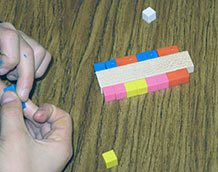How can centimeter cubes help us measure volume?
3. Explore cubic centimeters
While students are still in their small groups, distribute enough centimeter cubes so that each student can hold several.
- Do you think we could use these tiny cubes to help us measure volume?
- How could they help use figure out the correct order of the block?
Let the students brainstorm some ideas, then introduce the unit of measure. Holding up a cube:
- This is a small cube; in fact, every edge of this cube is just 1 centimeter long. The cube takes up only a small amount of space. That amount of space is called 1 cubic centimeter, and that’s the unit of measurement that scientists use to measure volume.

Write “cubic centimeters” in the empty cell of the “How We Measure Things” table. Explain that two of these cubes take up 2 cubic centimeters of space (or “have a volume of 2 cubic centimeters”) and five cubes have a volume of 5 cubic centimeters, and so on.
- Can you think of anything that takes up about 1 cubic centimeter of space?
- Where would one of these cubes go on our volume line?
Add a cube to the line, then draw attention to the investigation question:
Centimeter cubes and cubic centimeters: Students may be confused at first about the difference between centimeter cubes and cubic centimeters. Centimeter cubes are the physical cubes, often made from wood or plastic; they have a dimension of one centimeter along each edge. A cubic centimeter is the amount of space that a centimeter cube takes up; it is a standard measure for volume.
If you sense confusion, ask, “Are you talking about the object, or are you talking about the volume (or, the amount of space it takes up or, the unit of measure)?”



